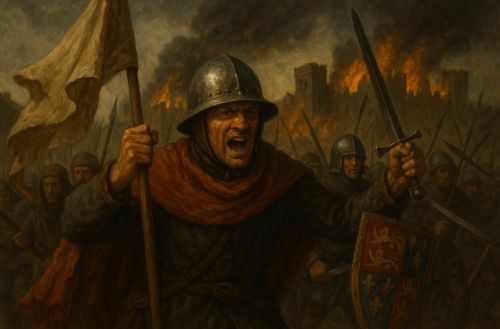

Jack Cade’s rebellion fused genuine grievances with political theater, articulated systemic critiques of government, and briefly turned London into a stage for the commons.

By Matthew A. McIntosh
Public Historian
Brewminate
Introduction: Popular Fury in the Late Medieval Realm
In the summer of 1450, England convulsed under the weight of rebellion. Jack Cade, a man of uncertain origins, gathered thousands of followers from Kent and the southeast, declaring himself the voice of the commons. For a brief moment, he commanded London, issuing proclamations, trying corrupt officials, and asserting the language of reform against a faltering monarchy.
What made Cade’s rebellion remarkable was not its violence but its articulation of systemic grievances. This was no peasant rising in the mold of 1381. Cade’s manifesto echoed constitutionalist tones, demanding justice, the curbing of corruption, and the restoration of good governance. The rebellion revealed a fragile kingdom in which monarchy persisted, but royal authority stood on crumbling ground.
The Political Context of 1450

By mid-century, Henry VI’s government was faltering. Unlike his father, Henry lacked the martial prowess and charismatic presence that had once secured the loyalty of nobles and commons alike. Instead, he proved pious, withdrawn, and prone to dependence on favorites whose influence only worsened public resentment.1
The loss of Normandy in 1450 symbolized the collapse of England’s continental ambitions. What had begun as a dynastic conquest under Henry V ended in humiliating retreat. English soldiers returned home embittered, veterans turned into vagrants, and taxpayers resented the endless burdens imposed to sustain wars that achieved little. The military defeat was not just strategic but psychological: it cast doubt on the crown’s ability to protect and lead the realm.2
At the center of this storm stood William de la Pole, Duke of Suffolk. Accused of enriching himself at the expense of the crown and negotiating dishonorable terms with the French, Suffolk became the lightning rod of discontent. When he was captured and executed at sea by angry subjects, the act was less a crime than a political reckoning.3 His fall, however, did not cure the ills of governance. It only revealed the extent to which royal authority was despised.
Thus, by the time Cade raised his banner, England was already a kingdom undone by mistrust. Henry VI remained the anointed monarch, but his rule was increasingly mediated by a sense that counselors betrayed the commonweal. Cade’s rebellion arose not out of sudden rage, but from the accumulation of grievances nourished by decades of failure.
The Outbreak of the Rebellion
Jack Cade himself is a figure enveloped in ambiguity. Chroniclers differ in their accounts: some described him as an Irish soldier, others a Kentish commoner, and still others insist he deliberately assumed the alias “John Mortimer” to align himself with the lineage of Richard, Duke of York.4 Whether opportunist or populist, Cade used identity as political theater, blurring the line between loyalty to the king and hostility to his counselors.
The rebels’ manifesto, “The Complaint of the Poor Commons of Kent,” laid out demands that spoke not of anarchy but of reform. They accused royal officers of extortion, criticized the exclusion of York from the king’s council, and demanded justice accessible to rich and poor alike.5 This was a strikingly literate rebellion, couched in the language of constitutional redress rather than the overthrow of monarchy. Cade’s genius lay not only in mustering men but in giving their fury a coherent ideological form.
The March on London

Cade’s army advanced with remarkable discipline in its early stages. At Sevenoaks, they defeated a royal force, a victory that gave them legitimacy in the eyes of many who saw divine favor in their cause. This triumph emboldened the rebels to push forward to the gates of London, where they were received not as outlaws but as agents of justice.
Once inside the city, Cade sought to transform rebellion into governance. He held mock trials of unpopular officials, most notably executing Lord Saye and Sele, the treasurer, in a ritualized performance of justice.6 These spectacles carried deep political meaning: the rebels were not indiscriminate rioters but claimed to act as arbiters of the commonwealth. By assuming judicial authority, Cade cast himself as a corrective to corrupt governance.
For several days in early July, London was under rebel occupation. The city became a stage for Cade’s attempt to demonstrate that the commons could reform government. Markets continued, proclamations were issued, and the rebellion momentarily appeared as a shadow kingdom, functioning parallel to the crown’s authority. The symbolism of London’s occupation cannot be overstated: it was not only the seat of trade but the heart of monarchy. To hold it, even briefly, was to seize the realm’s pulse.
Yet discipline frayed. Looting and violence alienated London’s citizens, who had initially welcomed Cade’s men as reformers. What began as order tipped into disorder, and public sympathy quickly evaporated. By mid-July, the city’s gates were shut against the rebels, and armed resistance forced Cade’s retreat. The rebellion’s unraveling was as swift as its rise, a reminder of the precarious balance between legitimacy and chaos.
Cade fled but was mortally wounded in Sussex. His body was brought back to London, where his head was displayed on London Bridge. The spectacle marked not only the end of Cade’s life but the ritual reassertion of royal authority. Yet the government had won only a pyrrhic victory, for the grievances that fueled the rebellion remained unaddressed.
The Meaning of Cade’s Rebellion
Cade’s rising failed in immediate terms. It did not depose corrupt officials, secure York’s return, or permanently reform government. Yet its meaning lies less in success than in the articulation of political discontent. By demanding accountability and invoking the language of justice, the rebellion crystallized popular frustration in a form that could not be ignored.
Historians have long debated its character. Was it revolutionary, a rehearsal for civil war, or a medieval complaint within the accepted tradition of loyal protest? The answer may be all three. Its organization and ability to seize London suggest ambition beyond local grievance, yet its rhetoric remained steeped in loyalty to the king. Cade did not demand Henry VI’s deposition, only his purification through the removal of traitorous counselors.7 The paradox of medieval rebellion lies precisely here: loyalty expressed through defiance.
The rebellion also reveals the political sophistication of the commons. Their manifesto, carefully worded, framed grievances as constitutional, suggesting awareness of the language of law and governance. This was not spontaneous fury, but a coherent demand for reform articulated through the voice of the commonwealth. Cade’s rebellion, therefore, was both a symptom of systemic breakdown and an expression of political imagination.
Cade, York, and the Shadow of Civil War

Though Cade fell, the specter of his rebellion lingered. His adoption of the Mortimer name implied at least an indirect connection with Richard, Duke of York. While there is little evidence of Yorkist orchestration, Cade’s rising anticipated the political challenge York would soon mount. The rebellion demonstrated that grievances articulated in Kent could destabilize monarchy itself, foreshadowing the dynastic conflict that would erupt within a decade.
The rebellion also underscored Henry VI’s inadequacy as a ruler. His inability to prevent disorder, his passivity in crisis, and his reliance on unpopular counselors weakened the crown irreparably. Cade’s uprising was not the cause of the Wars of the Roses, but it illuminated the cracks in the edifice of monarchy that those wars would shatter.
Conclusion: A Rebellion Remembered
Jack Cade’s rebellion of 1450 remains one of the defining moments of late medieval England. It fused genuine grievances with political theater, articulated systemic critiques of government, and briefly turned London into a stage for the commons. Though it collapsed in failure, it revealed the instability of monarchy under Henry VI and foreshadowed the wars that would consume the realm.
Cade’s rebellion endures not as a failed insurrection but as a mirror of a kingdom in crisis. It reminds us that rebellion arises where governance falters, and that even in failure, the voices of the commons echo through history, demanding justice in the face of corruption.
Appendix
Footnotes
- Bertram Wolffe, Henry VI (New Haven: Yale University Press, 1981), 214–218.
- Ralph A. Griffiths, The Reign of King Henry VI (London: Benn, 1981), 545–550.
- John Watts, The Making of Polities: Europe, 1300–1500 (Cambridge: Cambridge University Press, 2009), 385.
- Anthony Goodman, The Wars of the Roses: Military Activity and English Society, 1452–97 (London: Routledge, 1990), 22–24.
- A.L. Brown, “The Authorship of the ‘Complaint of the Poor Commons of Kent’,” Bulletin of the Institute of Historical Research 29 (1956): 33–42.
- Helen Castor, Blood and Roses: The Paston Family in the Fifteenth Century (London: Faber and Faber, 2004), 172–176.
- Watts, The Making of Polities, 388–389.
Bibliography
- Brown, A. L. “The Authorship of the ‘Complaint of the Poor Commons of Kent’.” Bulletin of the Institute of Historical Research 29 (1956): 33–42.
- Castor, Helen. Blood and Roses: The Paston Family in the Fifteenth Century. London: Faber and Faber, 2004.
- Goodman, Anthony. The Wars of the Roses: Military Activity and English Society, 1452–97. London: Routledge, 1990.
- Griffiths, Ralph A. The Reign of King Henry VI. London: Benn, 1981.
- Watts, John. The Making of Polities: Europe, 1300–1500. Cambridge: Cambridge University Press, 2009.
- Wolffe, Bertram. Henry VI. New Haven: Yale University Press, 1981.
Originally published by Brewminate, 09.02.2025, under the terms of a Creative Commons Attribution-NonCommercial-NoDerivatives 4.0 International license.


